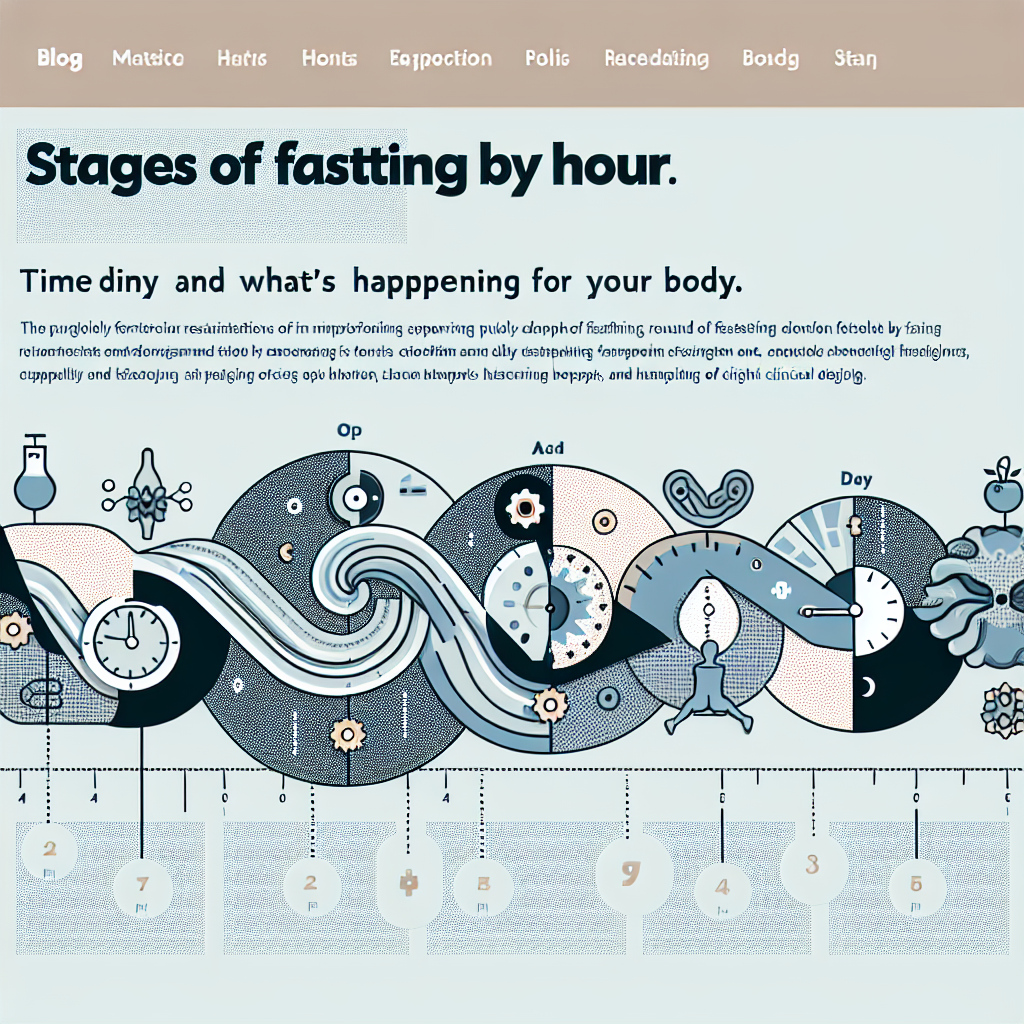Understanding the stages of fasting by hour helps you know what’s happening metabolically as your body moves from fed to fasted states. This timeline overview walks through typical hourly changes — from blood sugar regulation and digestive rest to the shifts into ketosis and cellular cleanup — and highlights practical considerations whether you’re trying intermittent fasting or longer fasts.
Stages of Fasting, Hour by Hour: a practical timeline
Many fasting charts and autophagy fasting chart resources break fasting into zones or stages to show when common effects occur. Below is a straightforward fasting chart by hour that summarizes typical changes for an otherwise healthy adult. Individual responses vary based on activity level, prior diet, and metabolic health.
- 0–4 hours (fed state): Your body is digesting and absorbing nutrients; insulin is elevated and most energy comes from recently eaten carbohydrates.
- 4–12 hours (post-absorptive): Insulin falls, glycogen in the liver starts to be used. Many people using stages of intermittent fasting end their eating window around this period.
- 12–24 hours: Liver glycogen becomes depleted for many people; blood glucose is maintained by gluconeogenesis. Initial ketone production begins in low amounts; this is often the first hourly benefits of fasting chart milestone.
- 24–48 hours: Ketosis becomes more pronounced, and autophagy processes increase as the body recycles damaged cellular components. This period is noted in many intermittent fasting ketosis chart summaries.
- 48–72 hours: Deeper ketosis and immune system effects may become noticeable. Many people report increased mental clarity and reduced appetite; this is a common checkpoint in a fasting chart and for those comparing 96 hour fast stages to shorter protocols.
- 72–120 hours (extended fast): Autophagy and cellular repair processes continue; fat stores are a primary fuel. Research and anecdotal reports outline potential 120 hour fasting benefits, but risks increase and medical supervision is advised for prolonged fasts.
These fasting zones give a general framework. For readers wanting an overview of fasting science, a neutral resource such as the fasting overview on Wikipedia is a helpful starting point: fasting overview (Wikipedia).
What happens during longer fasts: 96 vs 120 hour fast
Comparing 96 vs 120 hour fasts highlights how incremental time influences physiological effects. The 96 hour fast stages typically show clear ketosis and measurable autophagy; by 120 hours some people report stronger mental clarity and deeper metabolic shifts, which supporters list among 120 hour fasting benefits. However, longer fasts can also increase risk of electrolyte imbalance, muscle loss, and dizziness. If you’re exploring 96 vs 120 hour fast for potential benefits, consider consulting a healthcare professional and approach refeeding carefully.
Using fasting charts and practical tips
Many people find a visual fasting chart or intermittent fasting ketosis chart useful for planning. An hourly benefits of fasting chart can help set expectations: early hours are about hunger and glucose adjustments, mid-range hours bring fat adaptation and rising ketones, and later hours emphasize autophagy and repair. Practical tips include staying hydrated, monitoring electrolytes during multi-day fasts, and breaking long fasts with gentle, nutrient-dense foods.
If you’re specifically considering a multi-day fast like a 96-hour fast, review detailed guidance on what to expect and how to do it safely in our in-depth guide: what to expect during a 96-hour fast.
Who should be cautious
Fasting isn’t appropriate for everyone. People who are pregnant, breastfeeding, underweight, or with certain medical conditions (diabetes on insulin, eating disorders, uncontrolled medical problems) should avoid prolonged fasting unless supervised. Even healthy adults should treat extended fasting like a clinical intervention: plan, stay hydrated, and stop if severe symptoms occur.
- Use a fasting chart or fasting chart by hour to plan activity and rest periods.
- Track electrolytes during longer fasts and adjust sodium, potassium, magnesium as needed.
- Understand the stages of intermittent fasting and how they map to your goals (weight loss, metabolic health, or cellular repair).
Combining knowledge from an autophagy fasting chart with personal monitoring helps you find a safe, sustainable approach. Remember that many benefits attributed to fasting depend on context: calorie history, sleep, stress, and activity all influence outcomes.
Takeaways
- Fasting progresses through predictable metabolic stages: fed, post-absorptive, glycogen depletion, ketosis, then deeper autophagy and repair.
- Short fasts target glucose balance and fat adaptation; extended fasts (96–120 hours) may increase autophagy but carry higher risk and require planning.
- Use fasting charts and ketosis guides as frameworks, not strict rules; consult a clinician for multi-day fasts.
How quickly does ketosis begin?
Ketone production typically starts within 12–24 hours for many people and becomes more pronounced by 24–48 hours, though timing varies with prior carbohydrate intake and activity level.
Are longer fasts (96–120 hours) safe for weight loss?
Extended fasts can produce rapid weight loss and metabolic shifts, but they have greater risks (electrolyte imbalance, muscle loss). Compare 96 hour fast stages and 120 hour fasting benefits carefully; medical supervision is recommended for multi-day fasting.






